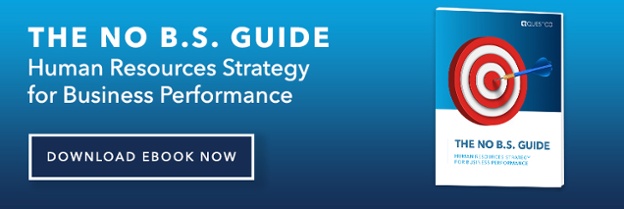
The role of an HR department in a company has evolved from simple recruitment into an integral part of business development. Depending on the approach, an HR strategy can either drive a company's success or hinder its growth potential.
A human resource strategy involves creating a plan to manage the actions of all employees and their development according to the company's needs. It encompasses a variety of tasks, from top talent recruitment and staff retention to defining labor relations and improving benefits.
HR Strategy vs HR Tactics
"Strategy without tactics is the slowest route to victory. Tactics without strategy are the noise before defeat," – Sun Tzu
Many companies confuse HR strategy with HR tactics. HR tactics are the tools an HR department is using to achieve goals identified by the strategy. For example:
- Goal: Higher retention rate
- Tactics: Leverage technology, improve benefits, implement a flexible schedule, invest in employee growth opportunities.
In short, an HR strategy is a set of goals. HR tactics are specific steps for achieving them.
Recruiting Strategy
One of the most important HR strategies is recruitment. The set of goals for a recruitment strategy revolves around recruiting the top talent that fits the company culture. It's a clear plan that explains which positions you want to recruit for as well as when, why, and how to do it.
To achieve the goals you set as part of the recruiting strategy, you can use the following tactics:
- Implement an employee referral program
- Encourage social recruiting
- Increase speed-to-hires
- Work on your brand (website, directories, advertising)
- Tweak job posts for accuracy
- Improve the interview process
- Reach out to previous employees
Your recruitment strategy depends on overall company goals and budget. With the world of recruitment changing rapidly, it's vital to review recruitment tactics on a regular basis.
Engagement Strategy
Employee engagement is a key factor in employee retention and productivity. According to the latest Achievers survey, only 19% of employees feel "very engaged" in their workplace. The main goal of any engagement strategy is engaging employees so that they are more productive and less likely to leave the company.
Examples of engagement strategy tactics include:
- Conduct an employee engagement survey
- Implement an employee recognition and rewards system
- Arrange fun employee engagement activities
- Promote flexible working hours to improve work-life balance
- Encourage the full use of vacations
- Ask for employees' opinions and make them count.
Designing an efficient engagement strategy can be complicated. You need to take a close look at your company culture, discover opportunities for employee engagement improvement, define the most applicable tactics, and start implementing them immediately.
Retention Strategy
The cost of turnover is extremely high. To replace an employee, companies pay about 50% to 60% of the employee's annual salary.
The key goal of a retention strategy is to get employees to stay with the company longer than they otherwise would. The main tactics to achieve this goal are:
- Increase engagement
- Implement a rewards system
- Show appreciation for each employee's achievements (large and small)
- Offer high-quality benefits
- Offer perks (free coffee, catered lunches, in-office gym, etc.)
- Encourage communication and analyze feedback
- Offer training and development opportunities
You need to revisit your employee retention strategy once every few months. If employees continue quitting, consider implementing employee exit interviews to get a better understanding of why your strategy is failing.
Growth Strategy
An efficient HR growth strategy should contribute to the company's success. One of the goals of such a strategy is helping the organization grow and develop.
While the rest of the strategies focus on employees, this one ties business and HR goals together. Some tactics to consider for the growth strategy involve:
- Improve the onboarding process and implement a new hires support program
- Put an emphasis on career development and training
- Create a healthy work culture of productivity
- Structure your incentive system to tie company goals to employees' work goals.
- Make company goals clear to the employees
Today, executives attribute 72% of their company's value to their employees. To make sure employees help the company grow, it's imperative to show how small steps taken by each team member affect large company objectives.
HR Outsourcing as a Strategic Multiplier
Designing and implementing HR strategies requires a multifaceted approach. Not all HR departments have a sufficient number of team members to ensure top-notch execution of all tactics.
Outsourcing HR can enhance the effectiveness of other strategies. By handing the tasks over to a large team of professionals, you can:
- Focus on analyzing employee needs, performance, and feedback
- Offer better benefits to encourage retention
- Reduce the time and resources spent on transactions and administration, thus focusing on strategic activities.
- Speed up response time on benefits enrollment and payroll
- Stay legally compliant
While you can outsource the full set of HR tasks to another company, it's possible to delegate only certain functions like payroll, benefits, and recruiting. Selective outsourcing can tailor HR tactics to suit the company's needs.
Tweaking Your HR Strategies
Without a full understanding of how HR strategies work, it's easy to get off track and focus on separate tactics.
Without keeping goals and objectives in mind, a set of top-notch tactics can turn into a random collection of steps that don't do anything toward improving the company's bottom line.
By designing efficient HR strategies, you can determine which HR tactics are appropriate and start working toward achieving the organization's goals.
.jpg)
Jason Randall
Jason L. Randall is the CEO of The Questco Companies. He regularly speaks on topics related to strategy, growth, and organizational performance.





